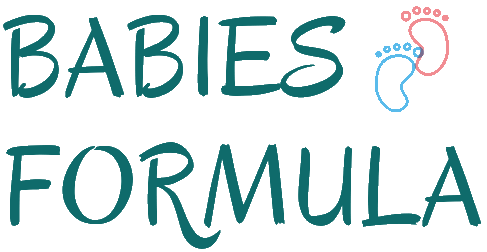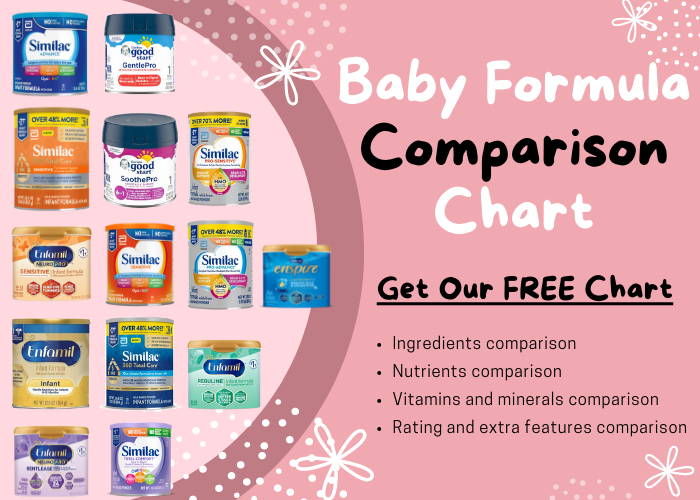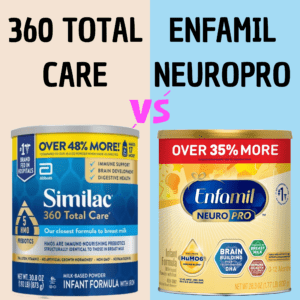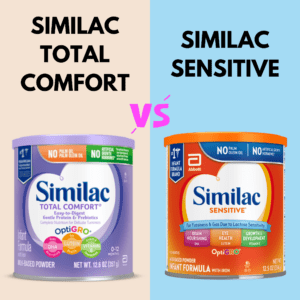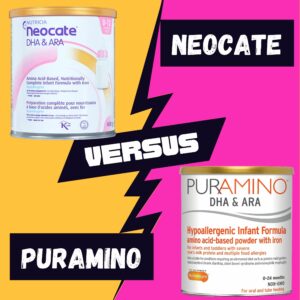What’s The Difference Between Similac Advance and Total Comfort?
The Difference is that Similac Advance is a standard infant formula suitable for babies who have no sensitivities or allergies, while Similac Total Comfort is designed for babies with digestive sensitivities due to lactose sensitivity because it’s lactose-reduced (by 98%) and contains partially hydrolyzed whey protein, making it gentler on sensitive tummies. Similac Advance contains intact cow’s milk and 100% lactose.
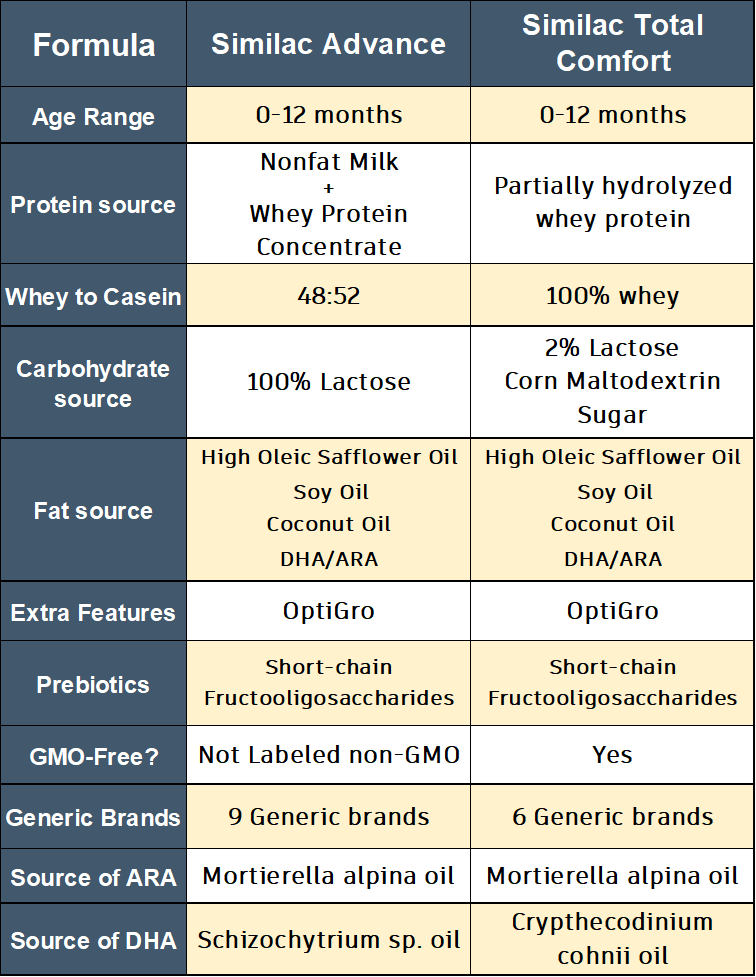
The Best One?
The choice between Similac Advance and Similac Total Comfort as the “best” formula depends on your baby’s specific needs and preferences. Neither formula is universally better than the other; it comes down to individual circumstances.
- Similac Advance is cost-effective, comes in various sizes, and offers a ready-to-feed option for convenience. It is suitable for babies without specific digestive sensitivities.
- Similac Total Comfort is designed for babies with mild digestive issues, and it may be a better choice if your baby experiences discomfort after feeding. However, it comes in a single size and is priced slightly higher per ounce.
Mom’s Reviews Comparison:

Similac Total Comfort:
Positive Reviews:
- Effective for Reducing Gas and Colic: Numerous moms praised Similac Total Comfort for its efficacy in reducing gas and colic in their babies. Many reported that their infants were noticeably less fussy and experienced fewer digestive discomforts when using this formula.
- Improved Bowel Movements: Another key benefit mentioned by moms was the improvement in their baby’s bowel movements. They noted that babies had more regular and comfortable stools while on this formula.
- Easier Digestion: Moms frequently reported that this formula was easier on their baby’s digestive system. Babies seemed to tolerate it well, with fewer instances of gassiness and discomfort after feedings.
- Better Sleep: Some moms also noted that their babies slept better after switching to Similac Total Comfort, which could be attributed to reduced discomfort and fussiness during the night.
Negative Reviews:
- Clumping and Foaming: Some mothers expressed concerns about clumping and foaming issues when preparing the Similac Total Comfort formula. These issues may have led to difficulties in mixing the formula properly.
- Gas and Diarrhea: While many babies had positive experiences, a few mothers reported that their infants experienced gas and diarrhea when using this formula, suggesting that it might not be suitable for all babies.
- Availability Concerns: Availability was a concern raised by a few moms, indicating that Similac Total Comfort might not be as readily accessible as it has one size available.
Related: Similac Total Comfort Vs. Enfamil Gentlease
Similac Advance:
Positive Reviews:
- Easy to Mix: Moms found Similac Advance easy to mix, which made it convenient for parents to prepare a quick and hassle-free bottle for their baby.
- No Digestive Issues: Many mothers reported that their babies had no noticeable digestive issues while using Similac Advance. These infants generally don’t have an allergy or sensitivity to specific ingredients.
- Good Taste: The formula’s taste received praise from several moms, as their babies seemed to enjoy it, making the transition from breast milk or another formula smoother.
- Cost-Effective: Some moms appreciated Similac Advance’s larger can size, which they found to be a cost-effective choice compared to smaller cans of other formulas.
Negative Reviews:
- Sensitivity Issues: A few mothers reported sensitivity issues in their babies, suggesting that Similac Advance might not be suitable for all infants, particularly those with specific sensitivities.
Related: Similac Advance Vs. Similac Sensitive
Ingredients Comparison:
Age Range:
Both formulas are suitable for infants from birth to 12 months. They provide complete nutrition for the first year of your baby’s life, helping support their growth and development during this critical stage.
Protein Source:
Similac Advance derives its protein from a combination of nonfat milk and whey protein concentrate. This blend of proteins offers a balanced source of nutrition, which is well-tolerated by many infants.
In contrast, Similac Total Comfort utilizes partially hydrolyzed whey protein. This means that the protein has undergone a process of partial hydrolysis, breaking it down into smaller, more easily digestible components. This makes it a preferred choice for babies with sensitive stomachs, as it reduces the likelihood of adverse reactions and digestive discomfort.
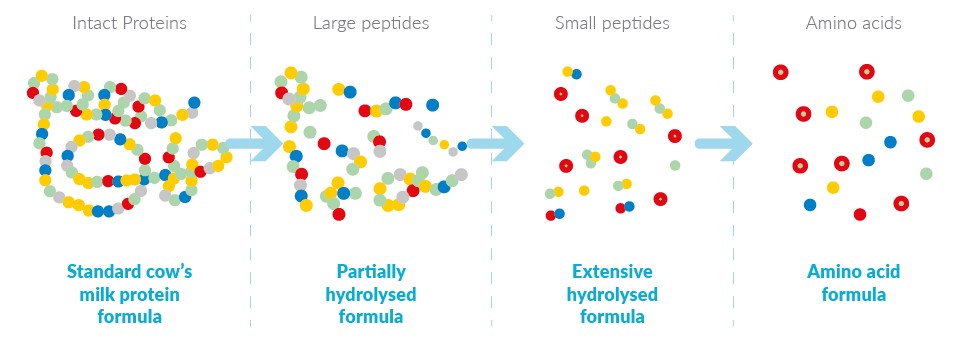
Whey to Casein Ratio:
Similac Advance provides a whey-to-casein protein ratio of 48:52. The balanced ratio mimics the protein composition found in breast milk, which is beneficial for many infants.
Similac Total Comfort consists of 100% whey protein. Whey protein is known for its easy digestibility and is often preferred for infants with sensitive tummies. This can make it a suitable choice for babies prone to colic and gas.
Carbohydrate Source:
The primary carbohydrate source in Similac Advance is lactose. Lactose is the natural sugar found in milk and is well-tolerated by most babies. It provides a good source of energy and is easier for digestion.
Similac Total Comfort uses a blend of carbohydrate sources, including 2% lactose, corn maltodextrin, and sugar. This combination offers an alternative carbohydrate profile, which is suitable for babies with lactose sensitivity.
Related: Similac Advance Vs. Pro Advance
Fat Source:
Both Similac Advance and Similac Total Comfort share a similar profile when it comes to fat sources. They include:
- High Oleic Safflower Oil
- Soy Oil
- Coconut Oil
- Both formulas contain DHA (Docosahexaenoic Acid) and ARA (Arachidonic Acid), essential fatty acids that support brain and eye development in infants.
Extra Features:
Both formulas contain OptiGRO, which is a blend of essential ingredients designed to support your baby’s growth and development. It includes DHA for brain development, lutein for eye health, and vitamin E for overall growth.
Prebiotics:
Both formulas include short-chain fructooligosaccharides (FOS) prebiotic, which is a prebiotic that promotes the growth of beneficial gut bacteria. This contributes to a healthier gut microbiome in your baby.
GMO-Free:
Similac Advance is not labeled as non-GMO. It does not make specific claims regarding the genetic modification of its ingredients.
Similac Total Comfort is non-GMO. This distinction is important for parents who prioritize non-genetically modified ingredients in their baby’s diet.
Generic Brands:
Similac Advance is associated with 9 generic brands, which means there are several more affordable alternatives available for parents who may be budget-conscious. Read Best 9 Generic Similac Advance.
Similac Total Comfort is linked to 6 generic brands. These alternatives can provide cost-effective options for parents who can’t afford the high price of this formula while maintaining the basic nutritional characteristics. Read Best 6 Generic Similac Total Comfort.
Source of ARA (Arachidonic Acid) and DHA (Docosahexaenoic Acid):
Both formulas derive ARA from Mortierella alpina oil, which is a microorganism known for producing this essential fatty acid.
The difference lies in the source of DHA; Similac Advance uses Schizochytrium sp. oil as the source of DHA whereas Similac Total Comfort sources its DHA from Crypthecodinium cohnii oil.
Nutrients Comparison:
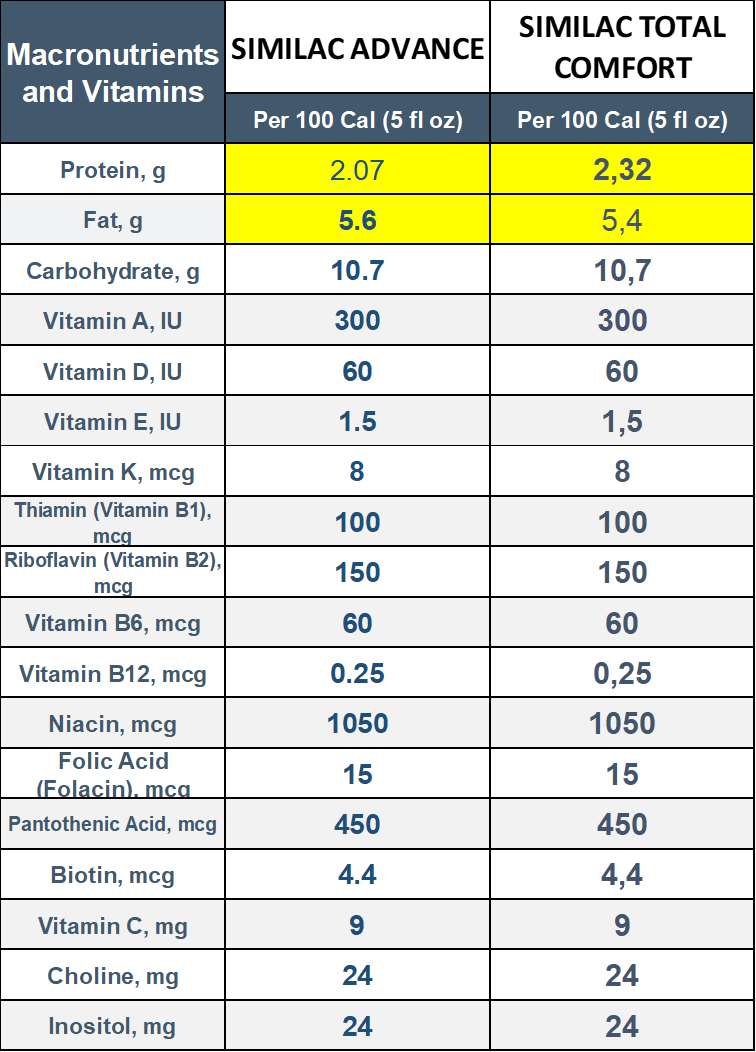
Macronutrients:
Protein, g:
- Similac Advance: Provides 2.07 grams of protein per 100 Cal.
- Similac Total Comfort: Offers slightly higher protein content at 2.32 grams per 100 Cal. This may be attributed to the use of partially hydrolyzed whey protein.
Fat, g:
- Similac Advance: Contains 5.6 grams of fat per 100 Cal.
- Similac Total Comfort: Offers slightly less fat with 5.4 grams per 100 Cal. The fat sources are similar in both formulas, including High Oleic Safflower Oil, Soy Oil, and Coconut Oil.
Carbohydrate, g:
- Similac Advance: Contains 10.7 grams of carbohydrates per 100 Cal, primarily derived from lactose.
- Similac Total Comfort: Also contains 10.7 grams of carbohydrates per 100 Cal, but it utilizes a combination of 2% lactose, corn maltodextrin, and sugar as carbohydrate sources.
Vitamins:
Both formulas have similar vitamins level including Vitamin A, E, D, K, C, and B Vitamins.
Minerals:
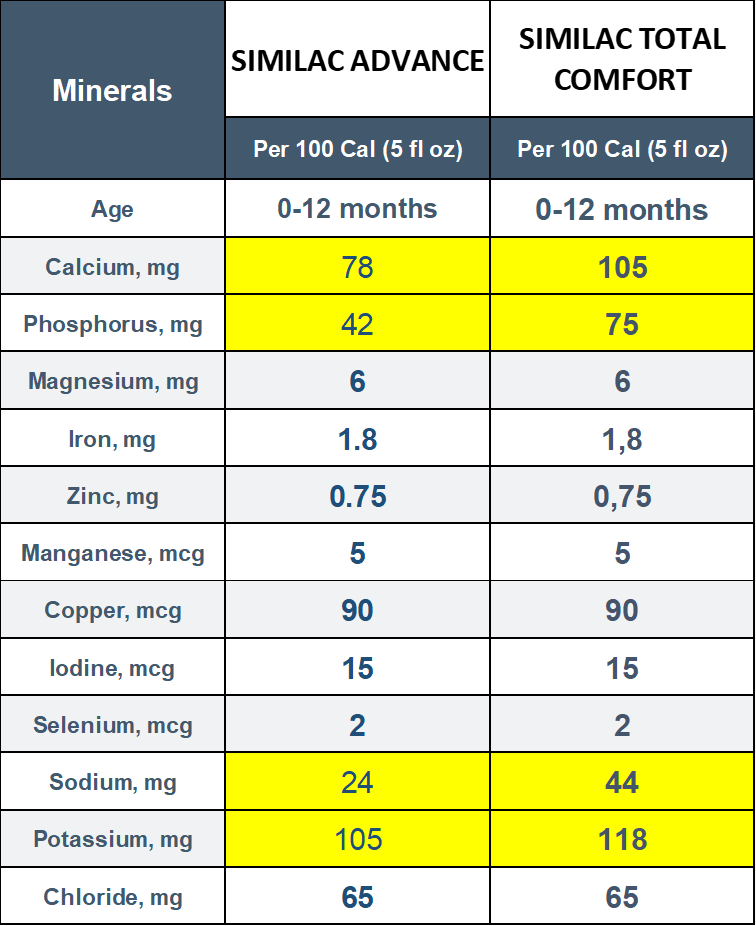
In terms of minerals, Similac Total Comfort is enriched more with minerals including Calcium (beneficial for bone development in infants), Phosphorus (important for bone and teeth formation and plays a role in energy metabolism), Sodium (plays a crucial role in maintaining fluid balance and regulating blood pressure in the body), and Potassium (vital for maintaining proper hydration, muscle function, nerve function, and heart health).
Related: Similac Advance vs 360 Total Care
Price Comparison:
| SIMILAC TOTAL COMFORT | SIMILAC ADVANCE |
|---|---|
| 12.6 oz $18.43 $1.54/oz Buy HERE | 12.4 oz 17.94 $ 1.45 /oz Buy HERE |
| – | 30.8 oz 32.54 $ 1.06 /oz Buy HERE |
| – | 40 oz 39.78$ 99.5 ¢/oz Buy HERE |
| – | 32 Fl Oz 7.82$ 24.4 ¢/fl oz Buy HERE |
| 4.5 of 5.0 654 reviews | 4.7 of 5.0 2290 reviews |
when comparing the cost-effectiveness of Similac Total Comfort and Similac Advance, it becomes evident that Similac Advance offers a cost advantage. The formula’s price per ounce decreases as you opt for larger container sizes, making it a budget-friendly choice for parents who prefer to purchase in bulk. For example, the 40 oz container of Similac Advance comes in at around $0.99 per ounce, offering substantial savings over time.
Moreover, the availability of ready-to-feed bottles in the Similac Advance line, though at a slightly higher upfront cost, can be considered a cost-effective option for busy parents seeking convenience and consistency.
Similac Total Comfort, while a suitable choice for those with babies who have specific digestive sensitivities, is available in a single size and at a slightly higher per-ounce price.
Can You Mix Similac Advance and Total Comfort?
It is generally not recommended to mix different infant formulas like Similac Advance and Similac Total Comfort because each one is specially formulated with specific ingredients to provide particular nutritional profiles. However, there are some cases in which you can mix them:
- Taste Preferences: If your baby seems to have a strong preference for the taste of one formula over the other, you might consider mixing the two to make the formula more palatable. However, it’s essential to monitor your baby’s reaction and adjust as needed.
- Temporary Transition: While it’s generally recommended to transition gradually from one formula to another, in some cases, parents may mix the two formulas as a temporary measure during the transition process. This can help ease the switch for babies who are resistant to change. However, the ultimate goal should be to fully transition to the new formula.
How to Switch From Similac Advance to Similac Total Comfort?
Switching from one infant formula to another, such as transitioning from Similac Advance to Similac Total Comfort is better to be done gradually and with care to minimize the potential for digestive discomfort. Here’s a step-by-step guide on how to make the switch:
Step 1: Consult Your Pediatrician Before making any changes to your baby’s formula, it’s essential to consult with your pediatrician or a healthcare professional. They can provide guidance based on your baby’s specific needs and ensure that the transition is safe and appropriate.
Step 2: Purchase Similac Total Comfort Acquire the Similac Total Comfort formula that you intend to switch to. Make sure you have enough of it to gradually transition your baby.
Step 3: Start with a Small Blend Begin the transition by mixing the two formulas. In the initial stages, you should have a mixture that is primarily Similac Advance with a small portion of Similac Total Comfort. For example, you might start with a ratio of 3 parts Similac Advance to 1 part Similac Total Comfort.
Step 4: Monitor Your Baby’s Reaction Observe how your baby responds to the mixed formula. Pay attention to their feeding behavior, bowel movements, and any signs of discomfort. While it’s normal for babies to take some time to adjust to a new formula, you should be vigilant for any adverse reactions.
Step 5: Gradually Increase Total Comfort over several days or weeks, gradually increase the proportion of Similac Total Comfort while decreasing Similac Advance. You might transition to a 1:1 ratio and then eventually shift to primarily Similac Total Comfort.
Step 6: Full Transition The ultimate goal is to have your baby fully transitioned to Similac Total Comfort. This process should be gradual to allow your baby’s digestive system to adapt.
Step 7: Adjust as Needed Be prepared to adjust the transition pace based on your baby’s specific response. If you notice any signs of digestive discomfort or if your baby is struggling with the change, consult with your pediatrician to determine the best approach.
Remember, every baby is unique, and their response to a formula switch may vary. The gradual transition minimizes the likelihood of digestive upset and allows your baby to adapt comfortably to the new formula.
References:
https://www.abbottnutrition.com/our-products/similac-advance-20
